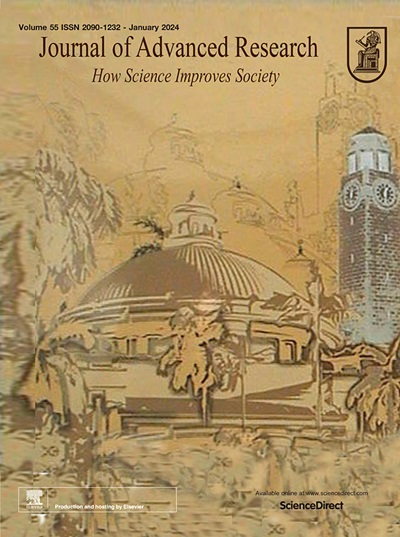Multifunctional nanoplatform for tumor chemodynamic and Self-Amplified photodynamic Cascade therapy
IF 11.4
1区 综合性期刊
Q1 MULTIDISCIPLINARY SCIENCES
引用次数: 0
Abstract
Introduction
5-Aminolevulinic acid (5-ALA)-based photodynamic therapy (PDT) has demonstrated considerable potential in breast cancer treatment. However, its efficacy is limited by low tissue selectivity and the rapid conversion of 5-ALA to non-photosensitive heme in tumor tissues, reducing its therapeutic effectiveness.Objectives
This study aims to develop a multifunctional nanomedicine to enhance 5-ALA’s PDT efficacy while introducing chemodynamic therapy (CDT) for synergistic tumor inhibition. By designing a zinc-ion-doped cuprous metal–organic framework (MOF) nanocarrier loaded with 5-ALA (5-ALA@Zn-CuTz), we seek to improve tumor targeting, prolong photosensitizer retention, and enhance therapeutic outcomes.Methods
To enhance biocompatibility and active tumor targeting, the surface of 5-ALA@Zn-CuTz nanoparticles (NPs) was modified with a platelet membrane (PM), forming 5-ALA@Zn-CuTz@PM NPs. The therapeutic efficacy was evaluated in vitro and in vivo using mice breast cancer models. Cellular uptake, reactive oxygen species (ROS) generation, and tumor inhibition efficiency were analyzed through fluorescence imaging, biochemical assays, and histological analysis.Results
Upon intravenous administration, 5-ALA@Zn-CuTz@PM NPs selectively accumulated in breast cancer cells. Within the tumor, Zn2+ bound to intracellular protoporphyrin IX (PpIX) to form PpIX-Zn, inhibiting heme oxygenase-1 (HO-1) activity and preventing the conversion of PpIX into heme. This increased the effective intracellular concentration of the photosensitizer, thereby enhancing PDT. Additionally, Cu+ catalyzed the decomposition of excess H2O2 in the tumor microenvironment, generating oxygen and hydroxyl radicals, which alleviated hypoxia and activated CDT. The synergistic PDT/CDT effect significantly enhanced tumor growth inhibition in vitro and in vivo.Conclusion
5-ALA@Zn-CuTz@PM NPs effectively enhance PDT efficacy through selective tumor targeting and HO-1 inhibition while simultaneously leveraging CDT for additional tumor suppression. The combined PDT/CDT strategy demonstrated superior therapeutic outcomes, highlighting the potential of this nanoplatform as a promising approach for breast cancer treatment.

求助全文
约1分钟内获得全文
求助全文
来源期刊

Journal of Advanced Research
Multidisciplinary-Multidisciplinary
CiteScore
21.60
自引率
0.90%
发文量
280
审稿时长
12 weeks
期刊介绍:
Journal of Advanced Research (J. Adv. Res.) is an applied/natural sciences, peer-reviewed journal that focuses on interdisciplinary research. The journal aims to contribute to applied research and knowledge worldwide through the publication of original and high-quality research articles in the fields of Medicine, Pharmaceutical Sciences, Dentistry, Physical Therapy, Veterinary Medicine, and Basic and Biological Sciences.
The following abstracting and indexing services cover the Journal of Advanced Research: PubMed/Medline, Essential Science Indicators, Web of Science, Scopus, PubMed Central, PubMed, Science Citation Index Expanded, Directory of Open Access Journals (DOAJ), and INSPEC.
 求助内容:
求助内容: 应助结果提醒方式:
应助结果提醒方式:


